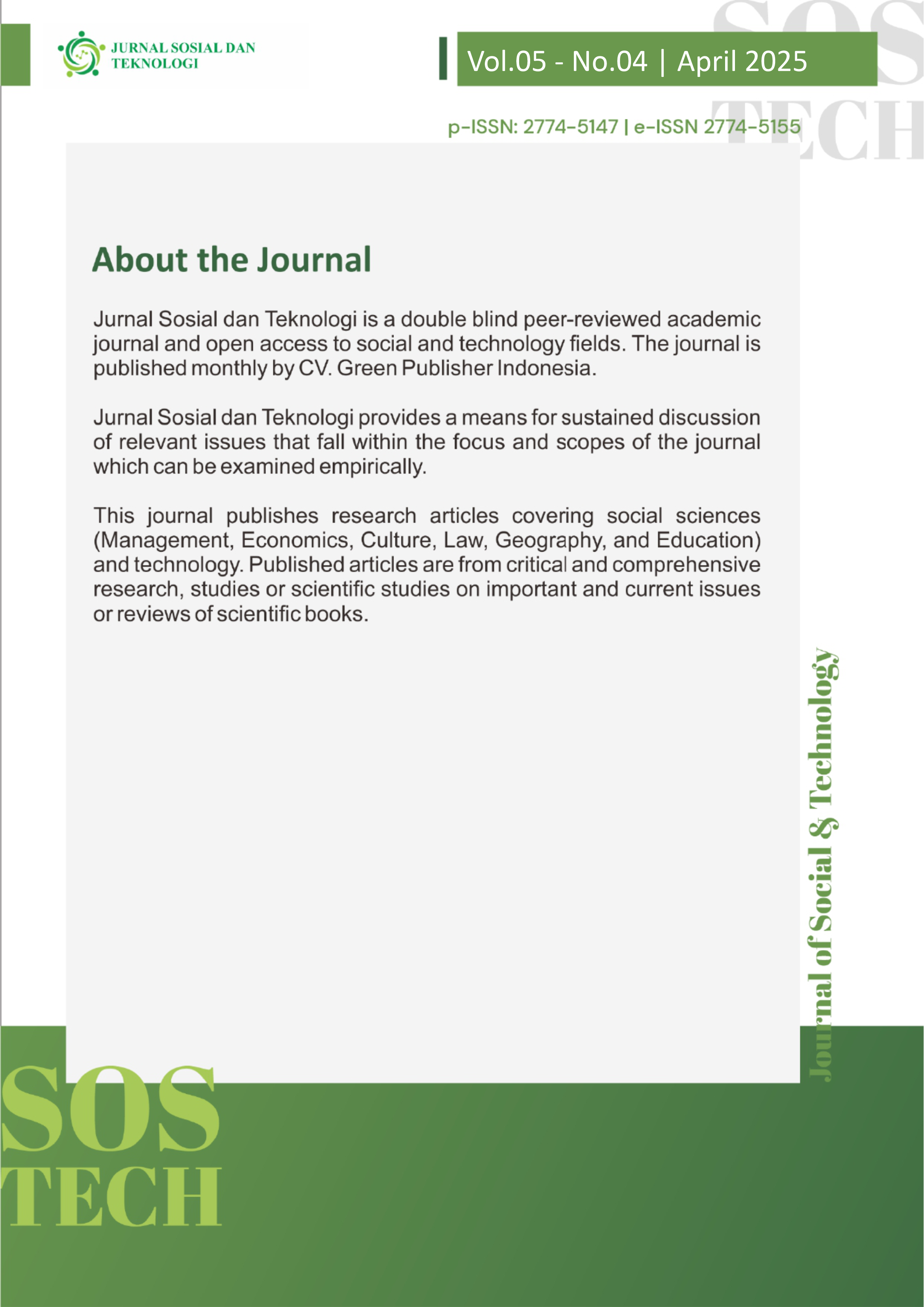Improvement Naive Bayes Menggunakan Forward Selection, Information Gain dan Gain Ratio untuk Penanganan Independensi Fitur
DOI:
https://doi.org/10.59188/jurnalsostech.v5i4.32084Keywords:
naive bayes, independensi fitur, seleksi fitur, pembobotan fitur, forward selection, information gain, gain ratio naive bayesAbstract
Penelitian ini bertujuan untuk menganalisis peningkatan kinerja algoritma Naive Bayes (NB) dalam menangani independensi fitur menggunakan metode Forward Selection, Information Gain, dan Gain Ratio. Naive Bayes merupakan algoritma klasifikasi yang sering digunakan karena efisiensi komputasinya yang tinggi, namun sering mengalami penurunan performa ketika ada ketergantungan antar fitur. Penelitian ini menggunakan pendekatan eksperimental dengan menerapkan beberapa algoritma, yakni Naive Bayes, Forward Selection Naive Bayes (FSNB), Forward Selection Information Gain Naive Bayes (FSIGNB), dan Forward Selection Information Gain Ratio Naive Bayes (FSIGRNB) pada dataset berdimensi tinggi. Metode validasi yang digunakan adalah 10-fold cross validation untuk mengukur akurasi setiap algoritma. Hasil penelitian menunjukkan bahwa algoritma FSNB dan FSIGNB berhasil meningkatkan akurasi secara signifikan dibandingkan dengan algoritma NB standar. FSNB memiliki akurasi rata-rata tertinggi sebesar 81,124%, diikuti oleh FSIGNB dan FSIGRNB. Implikasi dari penelitian ini adalah bahwa penerapan metode Forward Selection, Information Gain, dan Gain Ratio dapat meningkatkan akurasi klasifikasi Naive Bayes, terutama dalam dataset dengan dimensi fitur yang tinggi, serta memberikan kontribusi penting dalam pengembangan algoritma untuk menangani independensi fitur.
References
Annur, H. (2018). Klasifikasi Masyarakat Miskin Menggunakan Metode Naive Bayes. ILKOM Jurnal Ilmiah, 10(2). https://doi.org/10.33096/ilkom.v10i2.303.160-165
Asaad, R. R., & Abdulhakim, R. M. (2021). The Concept of Data Mining and Knowledge Extraction Techniques. Qubahan Academic Journal, 1(2). https://doi.org/10.48161/qaj.v1n2a43
Attamami, N., Triayudi, A., & Aldisa, R. T. (2023). Analisis Performa Algoritma Klasifikasi Naive Bayes dan C4.5 untuk Prediksi Penerima Bantuan Jaminan Kesehatan. Jurnal JTIK (Jurnal Teknologi Informasi Dan Komunikasi), 7(2). https://doi.org/10.35870/jtik.v7i2.756
Berrar, D. (2018). Bayes’ theorem and naive Bayes classifier. In Encyclopedia of Bioinformatics and Computational Biology: ABC of Bioinformatics (Vols. 1–3). https://doi.org/10.1016/B978-0-12-809633-8.20473-1
Damar Rani, H. A., & Zuhri, S. (2020). Sistem Prediksi Kondisi Kelahiran Bayi menggunakan Klasifikasi Naïve Bayes. Joined Journal (Journal of Informatics Education), 3(2). https://doi.org/10.31331/joined.v3i2.1432
Depari, D. H., Widiastiwi, Y., & Santoni, M. M. (2022). Perbandingan Model Decision Tree, Naive Bayes dan Random Forest untuk Prediksi Klasifikasi Penyakit Jantung. Informatik : Jurnal Ilmu Komputer, 18(3). https://doi.org/10.52958/iftk.v18i3.4694
Ericha Apriliyani, & Salim, Y. (2022). Analisis performa metode klasifikasi Naïve Bayes Classifier pada Unbalanced Dataset. Indonesian Journal of Data and Science, 3(2). https://doi.org/10.56705/ijodas.v3i2.45
Guohua, W., & Francis, E. H. (2017). Data Mining: Concept, Aplications and Techniques. ASEAN Journal on Science and Technology for Development, 17(1). https://doi.org/10.29037/ajstd.134
Harungguan, A. R., Napitupulu, H., & Firdaniza, F. (2023). Analisis Sentimen Dengan Metode Klasifikasi Naïve Bayes dan Seleksi Fitur Chi-Square. In Search, 22(2). https://doi.org/10.37278/insearch.v22i2.762
Istighfar, F., Negara, A. B. P., & Tursina, T. (2023). Klasifikasi Bidang Keahlian Mahasiswa Menggunakan Algoritma Naive Bayes. Jurnal Sistem Dan Teknologi Informasi (JustIN), 11(1). https://doi.org/10.26418/justin.v11i1.52402
Jiang, L., Li, C., Wang, S., & Zhang, L. (2016). Deep feature weighting for naive Bayes and its application to text classification. Engineering Applications of Artificial Intelligence, 52. https://doi.org/10.1016/j.engappai.2016.02.002
Mahmood, H. A. (2018). Network Intrusion Detection System (NIDS) in Cloud Environment based on Hidden Naïve Bayes Multiclass Classifier. Al-Mustansiriyah Journal of Science, 28(2). https://doi.org/10.23851/mjs.v28i2.508
Mostafa, A. A. N., & Mahmoud, H. E. A. (2022). Review of Data Mining Concept and its Techniques. International Journal of Academic Research in Business and Social Sciences, 12(6). https://doi.org/10.6007/ijarbss/v12-i6/13135
Nazneentarannum, M., & Rizvi, S. H. (2016). A Systematic Overview On Data Mining: Concepts And Techniques. International Journal of Research in Computer & Information Technology (IJRCIT), 1.
Prasdika, P., & Sugiantoro, B. (2018). A Review Paper on Big Data and Data Mining Concepts and Techniques. IJID (International Journal on Informatics for Development), 7(1). https://doi.org/10.14421/ijid.2018.07107
Ramadhan, T. D., Wahiddin, D., & Awal, E. E. (2023). Klasifikasi Sentimen Terhadap Pinjaman Online (Pinjol) Menggunakan Algoritma Naive Bayes. Scientific Student Journal for Information, Technology and Science, IV(1).
Rizki, M., Arhami, M., & Huzeni, H. (2021). Perbaikan Algoritma Naive Bayes Classifier Menggunakan Teknik Laplacian Correction. Jurnal Teknologi, 21(1). https://doi.org/10.30811/teknologi.v21i1.2209
Shafiee, S., Lied, L. M., Burud, I., Dieseth, J. A., Alsheikh, M., & Lillemo, M. (2021). Sequential forward selection and support vector regression in comparison to LASSO regression for spring wheat yield prediction based on UAV imagery. Computers and Electronics in Agriculture, 183. https://doi.org/10.1016/j.compag.2021.106036
Yang, C., Zhu, X., Qiao, J., & Nie, K. (2020). Forward and backward input variable selection for polynomial echo state networks. Neurocomputing, 398. https://doi.org/10.1016/j.neucom.2020.02.034
Zhang, L., Jiang, L., Li, C., & Kong, G. (2016). Two feature weighting approaches for naive Bayes text classifiers. Knowledge-Based Systems, 100. https://doi.org/10.1016/j.knosys.2016.02.017
Downloads
Published
How to Cite
Issue
Section
License
Copyright (c) 2025 Suprapto

This work is licensed under a Creative Commons Attribution-ShareAlike 4.0 International License.
Authors who publish with this journal agree to the following terms:
- Authors retain copyright and grant the journal right of first publication with the work simultaneously licensed under a Creative Commons Attribution-ShareAlike 4.0 International (CC-BY-SA). that allows others to share the work with an acknowledgement of the work's authorship and initial publication in this journal.
- Authors are able to enter into separate, additional contractual arrangements for the non-exclusive distribution of the journal's published version of the work (e.g., post it to an institutional repository or publish it in a book), with an acknowledgement of its initial publication in this journal.
- Authors are permitted and encouraged to post their work online (e.g., in institutional repositories or on their website) prior to and during the submission process, as it can lead to productive exchanges, as well as earlier and greater citation of published work.







